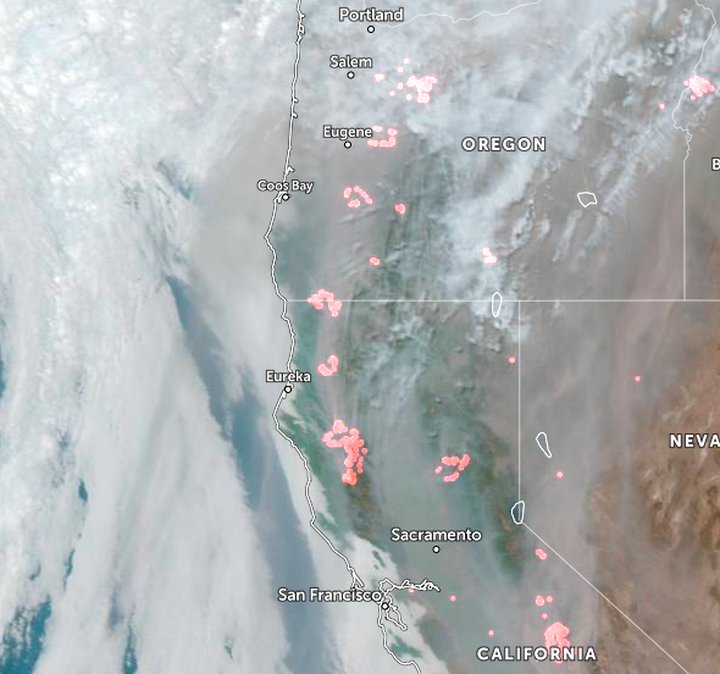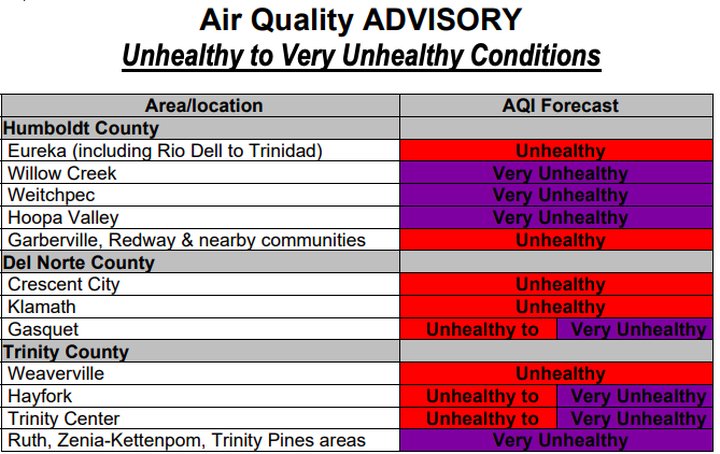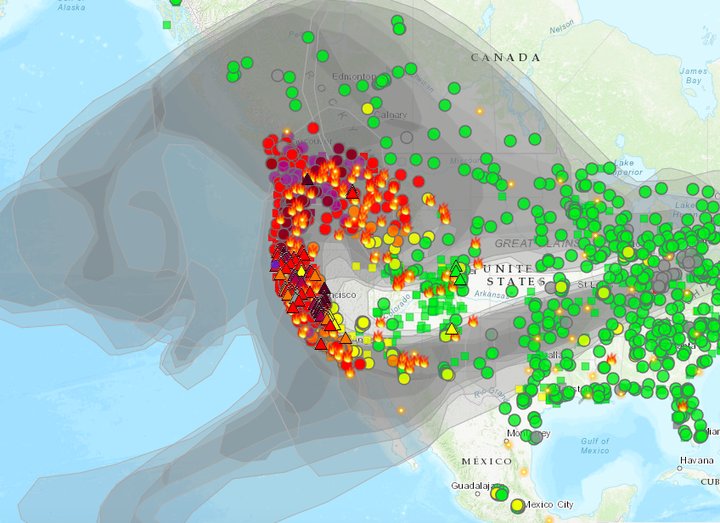WRO Staff / Monday, Sept. 14, 2020 @ 10:35 a.m.
The Air Outside is Still Absolute Garbage

The incinerating West. | Satellite imagery with fire spot overlay via zoom.earth.
###
Public service announcements from the North Coast Unified Air Quality Management District:

Smoke impacts from the fires are expected to reach HAZARDOUS conditions over the next 24 hours in the community of Orleans due to its proximity to the Red Salmon Complex fire. This forecast is expected to remain in effect until September 15, 2020. Updates will be provided as conditions change.

Smoke impacts from the fires are expected to reach Unhealthy to Very Unhealthy conditions over the next 24 hours in the communities indicated above. This forecast is expected to remain in effect until September 15, 2020. Updates will be provided as conditions change. A separate air quality ALERT for Hazardous conditions was issued today for Orleans. Air quality monitors for these communities can be viewed at https://fire.airnow.gov.
###
Several fires continue to impact our region with smoke: Red Salmon Complex, August Complex, Slater Fire, Elkhorn/Hopkins Fire, and Oak Fire, as well as numerous other fires in Oregon. USFS Air Resource Advisors (ARAs) are assigned to LRA fires impacting our area, provide daily smoke outlook forecasts that advise these notifications within our jurisdiction.
Continued fire growth and smoke production is expected today on the Red Salmon Complex. The ARA assigned to the fire indicates that smoke will combine with the Slater Fire and others, leading to continued poor air quality over the next few days. Smoke from the Red Salmon Complex is expected to be in the Very Unhealthy and Hazardous AQI range, depending on proximity to the fires. An Air Quality ALERT has been issued for Orleans which is forecast to have Hazardous conditions from smoke impacts given proximity to the fire. Air quality monitors can be viewed at https://fire.airnow.gov.
Weather conditions and fire activity will continue to push smoke from southern fires (August Complex, Oak Fire, and Elkhorn/Hopkins) to impact the communities in Southern Humboldt and Trinity County. The ARA on the fire indicates that increased transport winds overnight brought clearer skies above the fire and this may lead to increased fire activity today. With light southwesterly winds today and tomorrow expect some midday lessening of smoke which will settle back in overnight. Smoke from fires to the east and south continue to add to overall smoke concentrations.
Humboldt County – Air Quality ADVISORY issued today for Eureka (including Rio Dell to Trinidad), Hoopa, Weitchpec, Willow Creek, Garberville, and Redway areas; Air Quality ALERT was issued for Orleans.
- Eureka (including Rio Dell to Trinidad) – Mostly Unhealthy conditions with periods of Very Unhealthy possible.
- Orleans – Mostly Hazardous conditions likely.
- Weitchpec – Mostly Very Unhealthy, but with periods of Hazardous conditions likely.
- Hoopa – Very Unhealthy conditions likely.
- Willow Creek – Very Unhealthy conditions likely.
- Garberville & Redway and nearby communities – Unhealthy with periods of Very Unhealthy conditions.
Del Norte County – Air Quality ADVISORY issued today for Crescent City, Gasquet, Klamath.
- Crescent City – Unhealthy conditions likely.
- Gasquet – Mostly Unhealthy, but with periods of Very Unhealthy conditions due to proximity to fire.
- Klamath – Unhealthy conditions expected.
Particulate Matter (PM2.5) monitors are located in Crescent City, Gasquet, Eureka, Weaverville, Hoopa, Weitchpec, Willow Creek, Klamath, Trinity Center, Bridgeville, and Garberville. Updates will be provided as conditions change.
Fire information can be found at http://inciweb.nwcg.gov/ or https://fire.airnow.gov/. Current weather information can be found at www.wrh.noaa.gov. As with all wildfires, ash fallout is possible depending on fire activity and proximity to the fires. Ash fallout information can be found in the Wildfire Smoke Resources section of our webpage at www.ncuaqmd.org.
Health Information for Smoke Impacts
Concentrations of smoke may vary depending upon location, weather, and distance from the fire. Smoke from wildfires and structure fires contain harmful chemicals that can affect your health. Smoke can cause eye and throat irritation, coughing, and difficulty breathing. People who are at greatest risk of experiencing symptoms due to smoke include: those with respiratory disease (such as asthma), those with heart disease, young children, and older adults.
These sensitive populations should stay indoors and avoid prolonged activity. All others should limit prolonged or heavy activity and time spent outdoors. Even healthy adults can be affected by smoke. Seek medical help if you have symptoms that worsen or become severe.
Follow these general precautions to protect your health during a smoke event:
- Minimize or stop outdoor activities, especially exercise.
- Stay indoors with windows and doors closed as much as possible.
- Do not run fans that bring smoky outdoor air inside – examples include swamp coolers, whole-house fans, and fresh air ventilation systems.
- Run your air-conditioner only if it does not bring smoke in from the outdoors. Change the standard air conditioner filter to a medium or high efficiency filter. If available, use the “re-circulate” or “recycle” setting on the unit.
- Do not smoke, fry food, or do other things that will create indoor air pollution.
If you have lung disease (including asthma) or heart disease, closely monitor your health and contact your doctor if you have symptoms that worsen.
Consider leaving the area until smoke conditions improve if you have repeated coughing, shortness of breath, difficulty breathing, wheezing, chest tightness or pain, palpitations, nausea, unusual fatigue, lightheadedness.
Updated guidance from the CDC is available on reducing wildfire smoke exposure given COVID-19 considerations: https://www.cdc.gov/disasters/covid-19/reduce_exposure_to_wildfire_smoke_covid-19.html.
For further information, visit the District’s website at www.ncuaqmd.org or call the District’s Wildfire Response Coordinator at (707) 443-3093 x122.

Smoke cloud and air quality readings from airnow.gov.
CLICK TO MANAGE